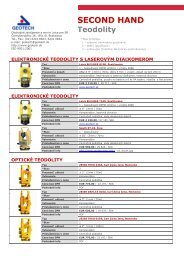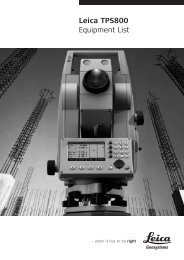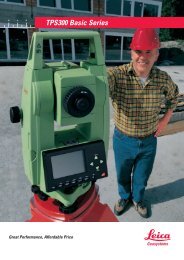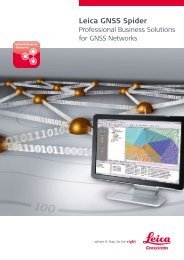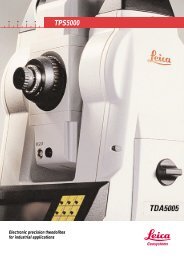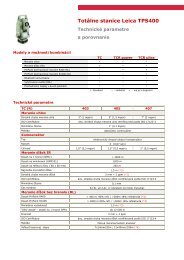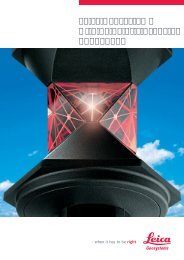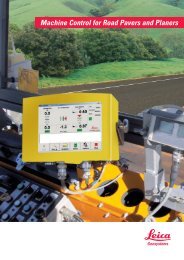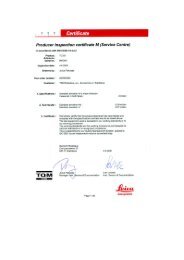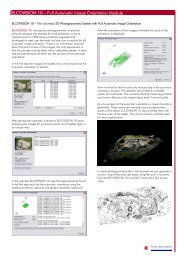Leica TS30 Technical Data - Geotech
Leica TS30 Technical Data - Geotech
Leica TS30 Technical Data - Geotech
You also want an ePaper? Increase the reach of your titles
YUMPU automatically turns print PDFs into web optimized ePapers that Google loves.
<strong>Leica</strong> <strong>TS30</strong><br />
<strong>Technical</strong> <strong>Data</strong>
<strong>TS30</strong> <strong>Technical</strong> <strong>Data</strong><br />
Models and Options<br />
Angle measurement<br />
Distance measurement (Prism)<br />
Distance measurement (Non-Prism)<br />
Distance measurement (Prism) – Long Range<br />
Motorised<br />
Automatic Target Recognition (ATR)<br />
PowerSearch (PS)<br />
Guide Light (EGL)<br />
Remote Control Unit (RX1250Tc)<br />
SmartStation (ATX1230+ GNSS)<br />
<strong>TS30</strong><br />
Standard<br />
Optional<br />
Angle measurement<br />
Description<br />
The highly accurate and reliable angle measurement system consists of a static line-coded glass circle, which is read by a linear<br />
CCD array. A special algorithm determines the exact position of the code lines on the array and determines the precise<br />
measurement instantly. As the code on the glass circle is absolute and continuous, no initialization of the instrument is required<br />
prior to measurements.<br />
A dual axis compensator constantly monitors both axes of the vertical axis tilt. The compensator consists of an illuminated line<br />
pattern on a prism, which is reflected twice by a liquid mirror forming the reference horizon. The reflected image of the line<br />
pattern is read by a linear CCD array and then used to mathematically determine both tilt components. These components are<br />
then used to immediately correct all angle measurements.<br />
<strong>TS30</strong><br />
Accuracy (std. dev. ISO 17123-3)<br />
Hz, V:<br />
Display least count:<br />
Method<br />
Compensator<br />
Working range:<br />
Setting accuracy:<br />
Method:<br />
0.5“ (0.15 mgon)<br />
0.01“ (0.01 mgon)<br />
absolute, continuous, quadruple<br />
4’ (0.07 gon)<br />
0.5“ (0.15 mgon)<br />
centralized quadruple axis compensation<br />
3
Distance measurement (Prism)<br />
Description<br />
In Prism mode, the PinPoint EDM of the <strong>TS30</strong> transmits a visible laser beam to specular targets such as prisms or reflector<br />
tapes. The reflected light is detected by a sensitive photo receiver and converted into an electrical signal. After digitizing and<br />
accumulating the signal, the distance is determined by means of modern phase measurement techniques. A modulation<br />
frequency of 100 MHz is the time base for the high distance accuracy. The coaxiality and the divergence angle of the laser<br />
beam together with the automatic target recognition (ATR), allows dynamic tracking of targets quickly and accurately in<br />
3 dimensions. For highest measurement precision towards dynamic targets the SynchroTrack mode offers simultaneous,<br />
isochronic Angle and Distance readings without latency.<br />
Range<br />
A B C<br />
Standard prism (GPR1): 1800 m (6000 ft) 3000 m (10000 ft) 3500 m (12000 ft)<br />
3 standard prisms (GPR1): 2300 m (7500 ft) 4500 m (14700 ft) 5400 m (17700 ft)<br />
360° prism (GRZ4, GRZ122): 800 m (2600 ft) 1500 m (5000 ft) 2000 m (7000 ft)<br />
360° mini prism (GRZ101): 450 m (1500 ft) 800 m (2600 ft) 1000 m (3300 ft)<br />
Mini prism (GMP101): 800 m (2600 ft) 1200 m (4000 ft) 2000 m (7000 ft)<br />
Reflector tape (60 mm x 60mm): 150 m (500 ft) 250 m (800 ft) 250 m (800 ft)<br />
Shortest measuring distance:<br />
1.5 m<br />
Atmospheric conditions:<br />
A: Strong haze, visibility 5 km; or strong sunlight, severe heat shimmer<br />
B: Light haze, visibility about 20 km; or moderate sunlight, slight heat shimmer<br />
C: Overcast, no haze, visibility about 40 km; no heat shimmer<br />
Accuracy (standard deviation ISO 17123-4) / Measure time<br />
Precise mode: 0.6 mm + 1 ppm / typ. 7 s 1)<br />
Standard mode:<br />
1 mm + 1 ppm / typ. 2.4 s<br />
Fast mode:<br />
3 mm + 1 ppm / typ. 0.8 s<br />
Tracking/SynchroTrack mode:<br />
3 mm + 1 ppm / typ. < 0.15 s<br />
Averaging mode:<br />
1 mm + 1 ppm<br />
Display resolution:<br />
0.1 mm<br />
Accuracy to reflective tape (60 mm x 60 mm)<br />
Precise/Standard/Averaging mode: 1 mm + 1 ppm 2)<br />
Fast/Tracking/SynchroTrack mode:<br />
5 mm + 1 ppm<br />
Display resolution:<br />
0.1 mm<br />
Method<br />
Type:<br />
Carrier wave:<br />
Measuring system:<br />
Coaxial, visible red laser<br />
658 nm<br />
System analyzer based on Phase Shift measurement ~ 100 MHz<br />
Distance measurement (Non-Prism)<br />
Description<br />
In Non-Prism mode, the Pin Point R1000 EDM of the <strong>TS30</strong> measures to targets more than 1000 m away. To measure to targets<br />
at such long distances with high measurement accuracy, a new measurement technology was developed. The main component<br />
of the EDM is a system analyzer, which uses modulation frequencies in the range of 100 MHz. The system analyzer properties<br />
are defined for each individual measurement for both the EDM beam and the target qualities. As a result of the system analysis,<br />
the parameters for every individual measurement are now known. The distance is calculated using modern signal processing<br />
based on the principle of maximum-likelihood. Besides the drastically increased sensitivity which leads to a sensational increase<br />
in reflectorless measurement range, the new EDM system provides many other advantages such as a very high measurement<br />
quality and reliability even when measuring in rain, fog, dust or snow. In addition the measurement system helps to prevent<br />
errors, by detecting if there are multiple targets within the measurement beam.<br />
1) atm. conditions type C, range up to 1000 m, GPH1P reflector<br />
2) Distance > 10 m, target aligned to instrument<br />
4
D E F<br />
Range<br />
Kodak Gray Card, 90% reflective: 800 m (2630 ft) 1000 m (3280 ft) > 1000 m (> 3280 ft)<br />
Kodak Gray Card, 18% reflective: 400 m (1320 ft) 500 m (1640 ft) > 500 m (> 1640 ft)<br />
Range of measurement:<br />
1.5 m to 1200 m<br />
Display unambiguous:<br />
up to 1200 m<br />
Atmospheric conditions:<br />
D: Object in strong sunlight, severe heat shimmer<br />
E: Object in shade, or sky overcast<br />
F: Underground, night and twilight<br />
Accuracy (standard deviation ISO 17123-4) / Measure time<br />
Standard mode 1) :<br />
2 mm + 2 ppm / typ. 3-6 s, max. 12 s<br />
Tracking Mode 2) :<br />
5 mm + 3 ppm / typ 0.25 s<br />
Atmospheric conditions:<br />
Display resolution:<br />
Object in shade, sky overcast (E)<br />
0.1 mm<br />
Laser dot size<br />
30 m: 7 mm x 10 mm<br />
50 m: 8 mm x 20 mm<br />
Method<br />
Type:<br />
Carrier wave:<br />
Measuring system:<br />
Coaxial, visible red laser<br />
658 nm<br />
System analyzer based on Phase Shift measurement 100 MHz - 150 MHz<br />
Distance measurement (Prism) – Long Range<br />
Description<br />
The highly collimated red laser beam of the PinPoint R1000 EDM can also be used to measure to prism targets at distances<br />
between 1000 m and 12000 m or reflector tape at extended ranges. The visibility of the laser beam simplifies the search of far<br />
distant reflectors, because the reflected light is even visible at distances more than 5000 m. The distance is measured by the<br />
same phase measurement technique used when measuring to prisms.<br />
The main module of the long range EDM is again a system analyzer (similar to the system analyzer used for reflectorless<br />
measurements) but with a reduced frequency set between 100 MHz and 150 MHz. The distance is calculated by an estimation<br />
method using modern signal processing incorporating the advantages such as high measurement quality and reliability when<br />
measuring in rain or snow positive and the detection of multiple targets within the measurement beam.<br />
A B C<br />
Range<br />
Standard prism (GPR1): 2200 m (7300 ft) 7500 m (24600 ft) > 10000 m (> 32800 ft)<br />
Reflector tape (60 mm x 60mm): 600 m (2000 ft) 1000 m (3300 ft) > 1300 m (> 4300 ft)<br />
Range of measurement to prism:<br />
1000 m to 12000 m<br />
Display unambiguous:<br />
up to 12000 m<br />
Atmospheric conditions:<br />
A: Strong haze, visibility 5 km; or strong sunlight, severe heat shimmer<br />
B: Light haze, visibility about 20 km; or moderate sunlight, slight heat shimmer<br />
C: Overcast, no haze, visibility about 40 km; no heat shimmer<br />
Accuracy (standard deviation ISO 17123-4) / Measure time<br />
Entire measurement range:<br />
3 mm + 1 ppm / typ. 2.5 s, max. 12 s<br />
Display resolution:<br />
0.1 mm<br />
Method<br />
Type:<br />
Coaxial, visible red laser<br />
Carrier wave:<br />
658 nm<br />
Measuring system:<br />
System analyzer based on Phase Shift measurement 100 MHz - 150 MHz<br />
1) < 500 m, > 500 m 4 mm + 2 ppm<br />
2) Accuracy and measure time depend on atmospheric conditions, target object and observation situation.<br />
5
Motorisation<br />
Description<br />
The motorisation uses a direct drive technology based on the piezo electric effect, which directly transforms electric power into<br />
mechanical movements. At each instrument axis a pair of diametrically mounted piezoceramics are utilised to accelerate and<br />
precisely move a ceramic cylinder ring attached to the rotating part of this axis.<br />
Characteristics of the piezo direct drive technology is the incorporation of maximum speed and acceleration capabilities together<br />
with the infinitesimal step sizes needed for highest precision measurements. The counteracting torque of the piezo technology<br />
enables highest motorisation speed at lowest power consumption. As a consequence of piezo technology's energy efficiency<br />
highest angular accuracies of 0.5" (0.15 mgon) and finest target positioning accuracies of 1mm become possible. Unmatched<br />
durability and extended maintenance cycles are achieved by a subsequent elimination of the transmission chain's moving parts.<br />
Maximum acceleration and speed<br />
Maximum acceleration: 400 gon (360°) / sec 2<br />
Rotating speed:<br />
200 gon (180°) / sec<br />
Time for change face:<br />
2.9 sec<br />
Positioning Time for 200 gon (180°):<br />
2.3 sec<br />
Method<br />
Principle:<br />
Direct drives based on Piezo technology<br />
Automatic Target Recognition (ATR)<br />
Description<br />
The ATR sensor transmits an invisible laser beam, which is reflected by any standard prism (no active prisms emitting special<br />
signals are required) and is received by an internal high-resolution CMOS camera. The intensity and the “spot” characteristics<br />
of the reflected light are calculated in respect to the CMOS camera center. The offset components from this reference are<br />
computed in both the vertical and horizontal planes. These offsets are then used to control the motors of the telescope axes,<br />
which react immediately to position the instrument’s crosshairs onto the prism. To minimize measurement time the crosshairs<br />
are only positioned within a 5 mgon tolerance (EDM mode IR STD) of the actual prism center. The remaining offsets are then<br />
mathematically applied to the Hz and V angles.<br />
Range<br />
ATR mode<br />
Lock mode<br />
Standard prism (GPR1): 1000 m (3300 ft) 800 m (2600 ft)<br />
360° prism (GRZ4, GRZ122): 800 m (2600 ft) 600 m (2000 ft)<br />
360° mini prism (GRZ101): 350 m (1150 ft) 300 m (1000 ft)<br />
Mini prism (GMP101): 500 m (1600 ft) 400 m (1300 ft)<br />
Reflector tape (60 mm x 60mm): 55 m (175ft) -<br />
Shortest measuring distance: 1.5 m 5 m<br />
Accuracy (std. dev. ISO 17123-3) / Measure time<br />
ATR angle accuracy Hz, V:<br />
1“ (0.3 mgon)<br />
Base Positioning accuracy:<br />
± 1 mm<br />
Measure time for GPR1:<br />
3-4 s<br />
The accuracy with which the position of a prism can be determined with Automatic Target Recognition (ATR) depends on several<br />
factors such as base positioning accuracy, instrument angle accuracy, prism type, selected EDM measuring program and<br />
the external measuring conditions. The ATR has a base positioning accuracy ± 1 mm. Above a certain distance, the instrument<br />
angle accuracy predominates and takes over the standard deviation of the ATR.<br />
Maximum speed (LOCK mode)<br />
Tangential (standard mode):<br />
Radial (tracking mode):<br />
Searching<br />
Search time in field of view:<br />
Field of view:<br />
Minimum spacing between prisms at 200 m:<br />
Definable search windows:<br />
Method<br />
Type:<br />
Carrier wave:<br />
Principle:<br />
9 m / s at 20 m, 45 m / s at 100 m<br />
5 m / s<br />
Typ. 1.5 s<br />
1° 30’ (1.66 gon)<br />
0.3 m<br />
Yes<br />
infrared laser, coupled with CMOS array<br />
785 nm<br />
Digital image processing<br />
6
PowerSearch (PS)<br />
Description<br />
This fast and reliable prism search uses a sender / receiver couple to detect prisms by means of digital signal processing<br />
algorithms. An invisible, vertical laser fan sized 40 gon in height and 0.025 gon in width is sent out while the instrument<br />
rotates around its standing axis. Once this fan comes across a prism, the reflected signal is evaluated on the<br />
fly to verify the target. If the specified signal patterns are matched, the horizontal position of the prism is determined<br />
and the rotation is stopped. Now an ATR search limited to the vertical line of the fan is launched, which precisely positions<br />
to the prism center. With this technique any standard prism (no active prisms emitting special signals are required)<br />
can be used.<br />
Range 1) Standard prism (GPR1):<br />
300 m (650 ft)<br />
360° prism (GRZ4, GRZ122) 2) : 300 m (650 ft) (perfectly aligned to the instrument)<br />
Mini prism (GMP101):<br />
100 m (330 ft)<br />
Shortest measuring distance:<br />
1.5 m<br />
Searching<br />
Search time 3) :<br />
Default search area:<br />
Definable search windows:<br />
Method<br />
Type:<br />
Carrier wave:<br />
Principle:<br />
5 sec<br />
Hz: 400 gon V: 40 gon<br />
Yes<br />
infrared laser, coupled with CCD array<br />
850 nm<br />
Digital signal processing<br />
Guide Light (EGL) for Stakeout<br />
Range<br />
Working range:<br />
5 m - 150 m<br />
Accuracy<br />
Positioning accuracy:<br />
5 cm at 100 m<br />
General data<br />
Telescope<br />
Magnification:<br />
Free objective aperture:<br />
Field of view:<br />
Focusing range:<br />
30 x<br />
40 mm<br />
1°30’ (1.66 gon) / 2.7 m at 100 m<br />
1.7 m to infinity<br />
Keyboard and Display<br />
Display:<br />
1/4 VGA (320*240 pixels), graphic LCD, colour, illumination, touch screen<br />
Keyboard:<br />
34 keys (12 function keys, 12 alphanumeric keys), illumination<br />
Angle display: 360° ’ “, 360° decimal, 400 gon, 6400 mil, V%<br />
Distance display:<br />
meter, int. ft, int. ft/inch, US ft, US ft/inch<br />
Position:<br />
face I and face II<br />
<strong>Data</strong> storage<br />
Internal memory:<br />
Memory card:<br />
Number of data records:<br />
Interface:<br />
Laser plummet<br />
Centering accuracy:<br />
Laser dot diameter:<br />
Operation<br />
Three endless drives:<br />
Userdefinable Smartkey:<br />
256 MB<br />
CompactFlash cards (256 MB, 1 GB)<br />
1750 / MB<br />
RS232, Bluetooth ® wireless<br />
1 mm at 1.5 m (deviation from plumb line)<br />
2 mm at 1.5 m<br />
For one and two hand manual operation<br />
For fast manual high precision measurements<br />
1) Average atmospheric conditions<br />
2) Target perfectly aligned to instrument<br />
3) Depending on target range<br />
7
Circular level<br />
Sensitivity:<br />
Power Management<br />
Standby power consumption:<br />
Internal battery (GEB241):<br />
Voltage:<br />
Capacity:<br />
Operating time:<br />
Dimensions<br />
Tilting axis height:<br />
Height:<br />
Width:<br />
Length:<br />
Weights<br />
Total station:<br />
Battery (GEB241):<br />
Tribrach (GDF121):<br />
Environmental specifications<br />
Working temperature range:<br />
Storage temperature range:<br />
Dust / water (IEC 60529):<br />
Humidity:<br />
6’ / 2 mm<br />
typ. 5.9 W<br />
Lithium-Ion<br />
14.8 V<br />
4.8 Ah<br />
9 h<br />
196 mm above tribrach<br />
351 mm<br />
248 mm<br />
228 mm<br />
7.25 kg<br />
0.4 kg<br />
0.8 kg<br />
-20°C to +50°C<br />
-40°C to +70°C<br />
IP54<br />
95%, non-condensing<br />
Onboard Software<br />
User Interface<br />
Graphics:<br />
Icons:<br />
Quick settings menu:<br />
Function keys:<br />
User menu:<br />
Graphical representation of points, lines and areas<br />
Application result plots<br />
Icons indicating the current status of measure modes, settings, battery etc.<br />
Quick settings menu for toggling reflectorless EDM, ATR, LOCK, EDM Tracking etc.<br />
on and off<br />
Direct function keys for quick and easy operation.<br />
User menu for quick access of the most important functions and settings<br />
Configuration<br />
Configuration sets:<br />
Displays masks:<br />
User menu:<br />
Hot keys:<br />
Coding<br />
Free Coding:<br />
Thematical Coding:<br />
Quick Coding:<br />
Smart Coding:<br />
Line Work:<br />
<strong>Data</strong> Management<br />
Jobs:<br />
8<br />
Points, lines, areas:<br />
Functions:<br />
Ability to store and transfer all instrument and application configuration settings<br />
for different operators, survey tasks etc.<br />
User definable measurement display<br />
User definable menu for quick access to specific functions<br />
User configurable hot keys for quick access to specific functions<br />
Recording codes with optional attributes in between of measurements<br />
Manual code entry or selection from a user defined codelist<br />
Coding points, lines and areas with optional attributes when measuring<br />
Manual code entry or selection from a user defined codelist<br />
Recording a measurement with a point, line, area or free code by entering an<br />
alphanumerical or a numerical quick code from a user defined codelist.<br />
Line and area quick codes automatically create line and area objects.<br />
Provides another quick and easy way of selecting a code and measuring a point.<br />
Simply use the touch screen to select the code from a user defined listing. This<br />
feature is integrated with all existing coding, linework and point measurement<br />
functionalities.<br />
Recording additional point information which effects creating lines, curves,<br />
splines, areas.<br />
User definable jobs containing measurements, points, lines, areas and codes<br />
Directly transferable to <strong>Leica</strong> Geo Office software<br />
Creating, viewing, editing, and deleting points, lines and areas and codes<br />
Sorting and filtering of points, lines and areas<br />
Averaging of multiple points within user defined averaging limits
<strong>Data</strong> Import & Export<br />
<strong>Data</strong> import:<br />
<strong>Data</strong> export:<br />
Character delimited ASCII files with point id, easting, northing, height and<br />
point code<br />
GSI8 and GSI16 files with point id, easting, northing, height and point code<br />
Direct onboard upload of DXF files for interactive maps and drawings<br />
User defined ASCII files with measurements, points, lines, codes<br />
SmartWorx TPS application programs<br />
(standard)<br />
Setup:<br />
Survey:<br />
Setting up and orienting the instrument using various set-up methods. For all<br />
setup methods that require a known setup point the coordinates can be<br />
measured by GNSS whenever a SmartAntenna is connected.<br />
Set Azimuth:<br />
Setting up the instrument on a known point and orienting to a backsight<br />
with known or unknown coordinates. Once the coordinates of the<br />
backsight are known all measurements are automatically updated.<br />
Known Backsight Point:<br />
Setting up the instrument on a known point and orienting to a known<br />
backsight point.<br />
Orientation and Height Transfer:<br />
Setting up the instrument on a known point and setting the orientation<br />
by measuring angles or angles and distances to known targets points.<br />
Resection, Resection Helmert:<br />
Setting up the instrument on an unknown point and set the orientation<br />
and calculate the station coordinates by measuring angles or angles and<br />
distances to up to 10 known targets points.<br />
Measuring points, lines and areas with codes and offsets.<br />
Auto Points:<br />
Tracking 3D movements of the target by automatically logging points at a<br />
given time interval, minimum distance difference or minimum height<br />
difference.<br />
Remote Points:<br />
Determining the 3D coordinates of inaccessible points by measuring the<br />
distance to a base point directly underneath or above the target and then<br />
measuring the angles to the inaccessible point.<br />
Stakeout: 3D Staking of points using various stakeout methods:<br />
Orthogonal:<br />
Displaying distances forwards / backwards, left / right from or to the<br />
station and cut / fill.<br />
Polar:<br />
Displaying direction, distance and cut / fill.<br />
Coordinate differences:<br />
Displaying coordinate differences and cut /fill.<br />
Stakeout direct from graphical map<br />
COGO:<br />
Determine Coordinate System:<br />
GNSS Survey:<br />
Computation of coordinates of points using various coordinate geometrical<br />
methods:<br />
Inverse: Compute bearing and distance between 2 points, point and line,<br />
point and arc and between point and the actual position.<br />
Traverse: Compute coordinates of points using bearing and distance from<br />
origin point<br />
Intersections: Compute coordinates of points using intersections created<br />
from other points<br />
Line Calculations: Compute coordinates of points based on distance and<br />
offsets along lines<br />
Arc Calculation: various arc related calculations, like arc center, offsetpoints<br />
related to an arc or segmentation of arcs<br />
Shift, Rotate and Scale: Compute coordinates of group of points based on<br />
a shift, rotate and scale from their existing coordinates. The shift, rotate<br />
and scale values can be manually entered or computed<br />
Area Division: Divide areas into smaller areas using a variety of methods<br />
GNSS coordinates are measured relative to the global geocentric datum known<br />
on WGS 1984. A transformation is required to convert the WGS 1984<br />
coordinates to local coordinates. Three different transformation methods are<br />
available:<br />
Onestep<br />
Twostep<br />
Classic 3D (Helmert transformation)<br />
Measuring points with GNSS if a SmartAntenna is connected, optional entry of<br />
codes.<br />
9
SmartWorx TPS application programs<br />
(optional)<br />
10<br />
Reference Line:<br />
Defining lines and arcs, which can be stored and used for other tasks, using<br />
various methods:<br />
Measuring to a line / arc where the coordinates of a target point are<br />
calculated from its current position relative to the defined reference line /<br />
arc.<br />
Staking to a line / arc where a target point is known and instructions to<br />
locate the point are given relative to the reference line / arc.<br />
Gridstaking to a line / arc where a grid can be staked relative to a<br />
reference line / arc.<br />
Defining and staking slopes along defined lines and arcs.<br />
DTM Stakeout: Staking out a Digital Terrain Model.<br />
Comparing actual and design height and displaying height differences.<br />
RoadRunner:<br />
Stake-out and as-built check of roads and any type of alignment related<br />
design (e.g. pipeline, cable, earthworks)<br />
Handles any combination of geometric elements in the horizontal<br />
alignment, from simple straights to different types of partial spirals<br />
Vertical alignment supports straights, arcs and parabolas<br />
Covers all working tasks including stake-out/check of lines, grades/slopes<br />
(e.g. road surface, cut & fill), DTMs and many more<br />
Visualization of cross-sections and planar view of design<br />
Graphical selection of elements to stake-out/check<br />
Smart project management of design data<br />
Support of multiple road layers (construction phases)<br />
Enhanced station equation capabilities<br />
Comprehensive, user definable log files and cut sheets<br />
Seamless data flow from all major design packages via PC conversion tool.<br />
RoadRunner Rail:<br />
Version of RoadRunner to stake-out and as-built check for rail construction<br />
and maintenance<br />
Stake-out of rails<br />
As-built checks of rails<br />
Superelevation (cant) supported<br />
Clearance (gauge) control<br />
View design data<br />
Reporting<br />
RoadRunner Tunnel:<br />
Version of RoadRunner to stake-out and as-built check for Tunnel construction<br />
and maintenance<br />
Stake-out of Tunnel Faces allows setting out at the point of excarvation<br />
(e.g. for Drill and Blast or excarvation using a roadheader)<br />
Stake-out of Tunnel Profiles for any point of the tunnel at the given<br />
chainage (e.g. after excavation to indicate the position of tunnel design<br />
elements or services such as lightning or ventilation.<br />
As-built checks of Tunnels by measuring profiles perpendicular to the<br />
centre line (Scan profile)<br />
As-built checks by measuring any point in the Tunnel and comparing<br />
the meassured point with the theoretical design point (Check profile)<br />
Support of multiple Tunnel layers (construction phases)<br />
View and edit design data<br />
Reporting<br />
Sets of Angles:<br />
Measuring directions and distances to targets in one or two faces in various<br />
measurement routines.<br />
Calculating the average directions and distances of all sets.<br />
Calculating the standard deviations for single directions / distance and<br />
average directions / distances.<br />
Monitoring option to repeat measurements at given time intervals.<br />
Traverse:<br />
Measuring a traverse with unlimited number of legs:<br />
Measuring sets to angles to backsight and multiple foresights.<br />
Measuring topographic points from any station.<br />
Using known points during traverse to validate quality of traverse.<br />
Calculating traverse closure results for field checking.<br />
Reference Plane:<br />
Stake-out or measure points relative to a reference plane:<br />
Defining a plane by either measuring or selecting points.<br />
Calculate the perpendicular distance and height difference from a<br />
measured point to the plane.<br />
Scanning of points on a defined plane.<br />
Cross Section Survey:<br />
Survey cross sections (such as highway profiles, river profiles, beach profiles)<br />
using code templates. The appropriate code for the next point on the profile is<br />
always correctly suggested<br />
Also shows distance from last cross section<br />
Free, point, line or area codes can be used
Area Division<br />
Area Division as an optional add on functionality of COGO Application<br />
Divide areas into smaller areas using a variety of methods<br />
Full graphical support<br />
Volume Calculation Defining and Editing of surfaces and boundaries<br />
Calculating of Digital Terrain Models<br />
Computation of Volumes of defined surfaces in relation of a defined<br />
reference height<br />
Hidden Point:<br />
Easily measures points that are not directly visibly by using a hidden point rod<br />
with 2 to 3 reflectors attached. The rod can be held at any angle and the<br />
spacing between reflectors is configurable. The program calculates the<br />
measurements to the hidden points as if they were observed directly.<br />
Monitoring:<br />
Monitoring is designed to assist you by automatically repeating measurements<br />
to defined targets at pre-defined measurement intervals. It is ideal for small<br />
scale monitoring applications without the need of a fixed PC set-up at the<br />
reference.<br />
Remote Control Unit (RX1250Tc)<br />
Description<br />
The RX1250Tc is a WinCE controller which uses the latest in spread spectrum 2.4 GHz radio technology to permitting total<br />
remote control of the <strong>TS30</strong> total station and GNSS Smart Antenna while at the Smart Pole. The RX1250Tc offers a next<br />
generation colour screen for bright, high contrast visibility in all conditions. Two different ways of remote controlling a <strong>TS30</strong> can<br />
be selected: the traditional concept mirrors the user interface of the <strong>TS30</strong> on the RX1250Tc. This easy to learn and simple to<br />
use concept ensures that no valuable measurement data is relayed over the radio link totally eliminating the risk of data loss.<br />
With the second concept, the RX1250Tc takes over the master role. All applications are running on the RX1250Tc, and all data<br />
are recorded into the database of the RX1250Tc. Further more, the RX1250Tc is completely interchangeable with both the <strong>TS30</strong><br />
and the GPS1200+ giving the user an efficient and economic solution to all sensor control needs. Such features result in a<br />
system, which offers total remote data flexibility. The full QWERTY keyboard of the RX1250Tc makes it easy and fast to enter<br />
alphanumeric point numbers, select or enter codes or even short descriptions. The encrypted protocol and frequency band<br />
hopping technology used in the data transmission greatly reduce the cases of interference from any other 2.4 GHz transmitters.<br />
In addition, a number of user selectable ‘link numbers’ can be configured easily in cases where more than one RX1250Tc is<br />
being used in the same area.<br />
Communication<br />
Communication:<br />
Control unit<br />
Display:<br />
Keyboard:<br />
Interface:<br />
Internal Battery (GEB211)<br />
Type:<br />
Voltage:<br />
Capacity:<br />
Operating time:<br />
Weights<br />
RX1250T/Tc:<br />
Battery (GEB211):<br />
Reflector pole adapter:<br />
via integrated radio modem<br />
1/4 VGA (320*240 pixels), graphic LCD, touch screen, illumination, colour<br />
62 keys (12 function keys, 40 alphanumeric keys), illumination<br />
RS232<br />
Lithium-Ion<br />
7.4 V<br />
2.2 Ah<br />
RX1250Tc: typ. 8 h<br />
0.8 kg<br />
0.1 kg<br />
0.25 kg<br />
Environmental specifications<br />
Working temperature range:<br />
Storage temperature range:<br />
Dust / water (IEC 60529):<br />
Waterproof (MIL-STD-810F):<br />
-30°C to +50°C<br />
-40°C to +80°C<br />
IP67<br />
temporary submersion to 1 m<br />
11
SmartStation (ATX1230+ GNSS)<br />
Description<br />
SmartStation is a <strong>TS30</strong> with ATX1230+ GNSS 120 channel GPS, GLONASS, Galileo, Compass Smart Antenna. All GNSS and TPS<br />
operations are controlled from the TPS keyboard, all data are in the same database, all information is shown on the TPS screen.<br />
RTK GNSS fixes the position to centimeter accuracy, then the setup routine is completed using the total station. SmartAntenna<br />
can also be used independently as a smart pole with the RX1250Tc Windows CE controller.<br />
Measurement precision and accuracy in position and accuracy in height are dependent upon various factors including number of<br />
satellites, geometry, observation time, ephemeris accuracy, ionospheric conditions, multipath etc. Figures quoted assume<br />
normal to favourable conditions. Times required are dependent upon various factors including number of satellites, geometry,<br />
ionospheric conditions, multipath etc. GPS and GLONASS can increase performance and accuracy by up to 30% relative to GPS<br />
only. A full Galileo and GPS L5 constellation will further increase measurement performance and accuracy.<br />
Accuracy<br />
Position accuracy:<br />
Horizontal: 10 mm + 1 ppm<br />
Vertical: 20 mm + 1 ppm<br />
When used within reference station networks the position accuracy is in<br />
accordance with the accuracy specifications provided by the reference station<br />
network.<br />
Initialisation<br />
Method:<br />
Real time (RTK)<br />
Reliability of initialisation: Better than 99.99%<br />
Time for initialisation:<br />
Typically 8 sec, with 5 or more satellites on L1 and L2<br />
Range:<br />
Up to 50 km, assuming reliable data-link is available<br />
RTK <strong>Data</strong> Formats<br />
RTK <strong>Data</strong> Formats for data reception:<br />
<strong>Leica</strong> proprietary formats (<strong>Leica</strong>, <strong>Leica</strong> 4G), CMR, CMR+, RTCM V2.1/2.2/2.3/3.x<br />
ATX1230 SmartAntenna<br />
Receiver technology:<br />
SmartTrack+ patented.<br />
Discrete elliptical filters. Fast acquisition. Strong signal. Low noise.<br />
Excellent tracking, even to low satellites and in adverse conditions.<br />
Interference resistant.<br />
Multipath mitigation.<br />
No. of channels ATX1230+ GNSS: 120, L1/L2/L5 GPS, GLONASS, Galileo, Compass 1)<br />
Groundplane:<br />
Built-in groundplane<br />
Dimensions (diameter x height):<br />
186mm x 89mm<br />
Weight:<br />
1.12kg<br />
1) The Compass signal is not finalized, although, test signals have been tracked with GPS1200+ receivers in a test environment.<br />
As changes in the signal structure may still occur, <strong>Leica</strong> Geosystems cannot guarantee full Compass compatibility.<br />
12
<strong>Leica</strong> Geo Office Software<br />
Description<br />
Easy, fast and comprehensive, automated suite of programs for TPS, GNSS and Level data. View and manage TPS, GNSS and<br />
Level data in an integrated way. Process independently or combine data – including post processing and support of real-time<br />
GNSS measurements.<br />
Manages all data in an integrated manner. Project management, data transfer, import/export, processing, viewing data, editing<br />
data, adjustment, coordinate systems, transformations, codelists, reporting etc.<br />
Consistent operating concepts for handling GNSS, TPS and level data, based on Windows standards. An embedded help system<br />
includes tutorials with additional information.<br />
Runs on Windows 2000, XP and Vista platforms.<br />
User Interface<br />
Intuitive graphical interface with standard Windows operating procedures. Customizable built-in configuration options allow<br />
users to set up the software exactly to suit their specific needs and preferences.<br />
Standard components<br />
<strong>Data</strong> and Project Management:<br />
Import & Export:<br />
ASCII Import & Export:<br />
View & Edit:<br />
TPS Processing:<br />
Cogo computations:<br />
Codelist Manager:<br />
Reporting:<br />
Tools:<br />
Fast, powerful database manages automatically all points and measurements<br />
within projects according to well-defined rules to ensure data integrity is<br />
always maintained.<br />
Projects, coordinate systems, antennas, report templates and codelists all have<br />
their own management.<br />
Numerous transformations, ellipsoids and projections, as well as user-defined<br />
geoid models and country specific coordinate systems which are based on a<br />
grid of correction values are supported. Six different transformation types are<br />
supported, giving the flexibility to select the approach which suits the project<br />
needs best.<br />
Antenna management system for offsets and correction values.<br />
Codelist management for code groups / code / attributes.<br />
Import data from compact-flash cards, directly from receivers, total stations<br />
and digital levels, or from reference stations and other sources via the<br />
Internet.<br />
Import of real-time (RTK), DGPS coordinates.<br />
Import coordinate lists as user-defined ASCII files using the import wizard.<br />
Export results in any format to any software using the ASCII export function.<br />
Transfer point, line, area, coordinate, code and attribute data to GIS, CAD<br />
and mapping systems.<br />
The various graphical displays form the basis for visualizing data and giving an<br />
instant overview of the data contained within a project. Point, line and area<br />
information may be viewed in View/Edit together with coding and attribute<br />
information. Editing functionality is embedded allowing to query and clean up<br />
the data before processing or exporting it further.<br />
Re-calculate TPS setups to update station coordinates and orientations<br />
Define setups and traverses and process with preferred parameters<br />
Display traverse results in HTML-based reports<br />
Computation of coordinates of points using various coordinate geometrical<br />
methods.<br />
Inverse: Compute bearing and distance between 2 points, point and line,<br />
point and arc and between point and the actual position<br />
Traverse: Compute coordinates of points using bearing and distance from<br />
origin point<br />
Intersections: Compute coordinates of points using intersections created<br />
from other points<br />
Line Calculations: Compute coordinates of points based on distance and<br />
offsets along lines<br />
Arc Calculation: various arc related calculations, like arc center, offsetpoints<br />
related to an arc or segmentation of arcs<br />
Shift, Rotate and Scale: Compute coordinates of group of points based on<br />
a shift, rotate and scale from their existing coordinates. The shift, rotate<br />
and scale values can be manually entered or computed<br />
Area Division: Divide areas into smaller areas using a variety of methods<br />
Generation of codelists with code groups, codes, and attributes.<br />
Management of codelists.<br />
HTML-based reporting provides the basis for generating modern, professional<br />
reports. Measurement logs in field book format, reports on averaged<br />
coordinates, various processing log files and other information can be<br />
prepared and output. Configure reports to contain the information that are<br />
required and define templates to determine the presentation style.<br />
Powerful Tools like Codelist Manager, <strong>Data</strong> Exchange Manager, Format Manager<br />
and Software Upload are common tools for GNSS receivers, total stations<br />
and also for digital levels.<br />
13
GNSS Options<br />
L1 data processing:<br />
L1 / L2 data processing:<br />
GLONASS data processing:<br />
RINEX Import:<br />
Level Options<br />
Level data processing:<br />
Design & Adjustment 1D:<br />
General Options<br />
Datum & Map:<br />
Design & Adjustment 3D:<br />
GIS / CAD Export:<br />
Surfaces & Volumes:<br />
System requirements<br />
Recommended PC configuration:<br />
Graphical interface for baseline selection, processing commands etc.<br />
Automatic or manual selection of baselines and definition of processing<br />
sequence.<br />
Single baseline or multi-baseline batch processing.<br />
Wide range of processing parameters.<br />
Automatic screening, cycle-slip fixing, outlier detection etc. Automated<br />
processing or user-controlled processing.<br />
Graphical interface for baseline selection, processing commands etc.<br />
Automatic or manual selection of baselines and definition of processing<br />
sequence.<br />
Single baseline or multi-baseline batch processing.<br />
Wide range of processing parameters.<br />
Automatic screening, cycle-slip fixing, outlier detection etc.<br />
Automated processing or user-controlled processing.<br />
Allows processing of GLONASS data in addition to GPS data processing.<br />
Import of data in RINEX format.<br />
View the data collected from the <strong>Leica</strong> digital level in the Geo Office level<br />
booking sheet. Select the preferred processing settings and process the level<br />
lines. Processing runs quickly and automatically. Use Results Manager to<br />
inspect and analyze the leveling results and generate a report. Finally, store<br />
the results and/or export them as required.<br />
Powerful MOVE3 Kernel with rigorous algorithms for 1D adjustment.<br />
Furthermore, network design and analysis is supported.<br />
<strong>Leica</strong> Geo Office supports numerous transformations, ellipsoids and<br />
projections, as well as user-defined geoid models and country specific<br />
coordinate systems, which are based on a grid of correction values. The<br />
optional Datum/Map component supports the determination of transformation<br />
parameters. Six different transformation types are supported, giving the<br />
flexibility to select the approach which suits the project needs best.<br />
Combine all measurements in a least-squares network adjustment to obtain<br />
the best possible set of consistent coordinates and check that the<br />
measurements fit with the known coordinates. Use adjustment to help<br />
identify blunders and outliers based upon the extensive statistical testing.<br />
Using the powerful MOVE3 Kernel, the algorithms are rigorous and the user<br />
can choose between whether a 3D, 2D or 1D adjustment is computed.<br />
Furthermore, the component supports network design – allowing to design<br />
and analyze a network before actually going into the field.<br />
Permits export to GIS/CAD systems such as AutoCAD (DXF / DWG), MicroStation<br />
Assign measured points of surfaces and calculate Digital Terrain Models<br />
Use automatic boundary creation or define boundaries manually<br />
Introducing breaklines will automatically update the model<br />
Visualize the surface in a 2D or 3Dview<br />
Calculate volumes above the reference heights or between surfaces<br />
Pentium ® 1GHz processor or higher<br />
512 MB RAM or more<br />
Microsoft ® Windows 2000, XP or Vista<br />
Microsoft ® Internet Explorer 5.5 or higher<br />
14
Whether you want to survey a skyscraper or a tunnel, monitor the<br />
movements of a volcano or objects on a construction site – you need<br />
reliable data. <strong>Leica</strong> Geosystems offers a complete portfolio of<br />
innovative solutions for precise surveying that deliver unprecedented<br />
accuracy, quality and performance. With <strong>Leica</strong> Geosystems no task is<br />
too challenging, leverage your professional imagination to success.<br />
<strong>Leica</strong> Geosystems’ customers benefit from service and support that<br />
spans time zones and geography. With true partnerships – it’s our<br />
commitment to continue to provide the level of support and<br />
collaboration you have come to expect when you put your trust in<br />
<strong>Leica</strong> Geosystems.<br />
When it has to be right.<br />
Illustrations, descriptions and technical specifications are not binding and may change.<br />
Printed in Switzerland – Copyright <strong>Leica</strong> Geosystems AG, Heerbrugg, Switzerland, 2009.<br />
766427en – III.09 – RVA<br />
Total Quality Management –<br />
our commitment to total<br />
customer satisfaction.<br />
Ask your local <strong>Leica</strong> Geosystems<br />
dealer for more information<br />
about our TQM program.<br />
Distance meter (Prism),<br />
ATR and PowerSearch:<br />
Laser class 1 in accordance<br />
with IEC 60825-1 resp.<br />
EN 60825-1<br />
Laser plummet:<br />
Laser class 2 in accordance<br />
with IEC 60825-1 resp.<br />
EN 60825-1<br />
Distance meter (Non-Prism):<br />
Laser class 3R in accordance<br />
with IEC 60825-1 resp.<br />
EN 60825-1<br />
The Bluetooth ® word mark and<br />
logos are owned by Bluetooth<br />
SIG, Inc. and any use of such<br />
marks by <strong>Leica</strong> Geosystems AG is<br />
under license. Other trademarks<br />
and trade names are those of<br />
their respective owners.<br />
<strong>Leica</strong> Geosystems AG<br />
Heerbrugg, Switzerland<br />
www.leica-geosystems.com




